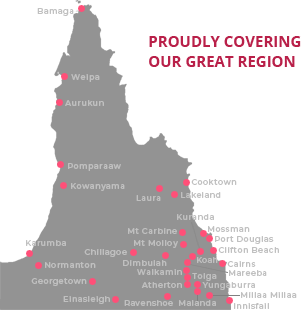On The Land
15 November, 2025
Lychee growers confident despite sporatic flowering
DESPITE sporadic flowering and fruit set this far, local lychee producers still remain confident of a successful season with many trees coming online as they mature.

On the Tablelands and the Mareeba Dimbulah Irrigation area, there are 40 lychee farms producing the much sought-after fruit.
According to last year’s Department of Agriculture Forestry and Fisheries’ five-yearly horticulture profile, lychee production covered a total of approximately 350 hectares, producing a total crop of 745 tonnes of fruit last season.
This survey confirmed that last year returned a Gross Value of Production (GVP) of $11.1 million. This was an improvement over the previous review in 2019 that confirmed 250 hectares were under production, returning a GVP of $6.3 million.
GVP refers to the value of production at wholesale prices in the marketplace. The values are calculated from multiple industry, government and grower sources, and are estimates only.
Lychees were introduced into Australia more than 150 years ago with the first lychee trees being brought into northern Australia in the 1870s by Chinese immigrants.
Australia’s oldest lychee orchard is located at East Trinity near Cairns and is run by direct descendants of the first Chinese settlers in this region, the Wah Day family.
Representing growers is the Australian Lychee Growers’ Association (ALGA), which has overseen a “small exotic fruit” industry develop into a progressive and robust industry with local medium and small establishments and many producers growing lychees as a supplementary crop.
Over the past 10 years, although a number of smaller orchards in North Queensland were destroyed by cyclones and unpredictable weather events, it has not impacted the overall annual tonnage as additional plantings were already underway with yields replacing any losses.
Depending on climatic conditions, the Australian lychee season commences in mid-October in Far North Queensland and ends in late March in northern New South Wales.
This gives the Australian industry a significant advantage over other suppliers on world markets as no other country can offer such a long line of supply of quality-controlled fresh lychee product.
The ALGA also noted Australia has an advantage internationally with production during the Northern Hemisphere “off season”, including the lucrative Christmas and Chinese New Year festivities, with demand for high-quality product far exceeding Australia’s ability to supply.
According to ALGA executive officer Jill Houser, the annual lychee tonnage for Queensland for the 2024-2025 was 2,622 tonnes, with a production value estimated at $40 million, of which the Tableland/Mareeba growing region yielded approximately 745 tonnes.
Export accounts for approximately 25% of the annual production, with Australian lychees exported to New Zealand, Hong Kong, Singapore, Malaysia, Indonesia, Europe, the Middle East, the UK, Canada and USA.


